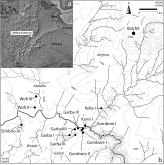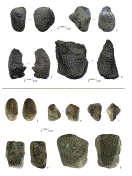Techno-economic behaviours at Garba IVD
Rosalia Gallotti
Source - http://www.sciencedirect.com/science/article/pii/S0047248413001619
Journal of Human Evolution
Abstract
In the 1970s and 1980s, the emergence of the Acheulean at Melka Kunture (Upper Awash, Ethiopia) was dated to 1 Ma (million years ago), based on the typo-metrical analysis of the lithic assemblage of Garba XIIJ. Older sites such as Gombore I, Karre I, and Garba IV (1.7–1.5 Ma) were classified as Oldowan/Developed Oldowan. Consequently, the Oldowan and the Acheulean at Melka Kunture were interpreted as two distinct technologies separated by a chronological gap of 0.5 Ma.
The archaeostratigraphic unit D of Garba IV, dated to ∼1.5 Ma, yielded one of the richest Early Stone Age lithic series in East Africa. In this paper, a review traces methods of technological analysis, based on the concept of chaîne opératoire, to update our knowledge of the techno-economic behaviours at this site. The results show two major elements characteristic of cultural changes in the Melka Kunture sequence: (1) the emergence of a new chaîne opératoire focused on large flake/large cutting tool (LCT) production, and (2) a large variability of small débitage modalities with systematic preparation of the striking platform and the appearance of a certain degree of predetermination.
These technological traits are shared by the contemporaneous sites in East Africa and are considered to be typical of the early Acheulean. This suggests an older origin for the Acheulean at Melka Kunture, 0.5 Ma than previously inferred.

Figure 1. (a) The location of Melka Kunture on the shoulder of the Main Ethiopian Rift in the map of Ethiopia and surrounding countries; (b) map of the Melka Kunture area (vector restitution of the 1:50,000 topographic map).

Figure 7. Unworked material at Garba IVD. 1, spherical cobble, OBS; 2, angular cobble, OBS; 3, angular element, OBS; 4, small block, OBS; 5, elongated cobble, ASB; 6–7, angular cobbles (6, ASB; 7, PB); 8, small block, MFL compact facies; 9, block, PB. ASB, aphyric to subaphyric basalts; MFL, Melka Fault lava; OBS, obsidian; PB, porphyritic basalts.